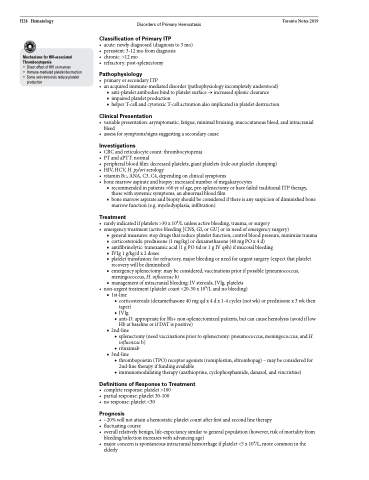Page 568 - TNFlipTest
P. 568
H28 Hematology
Disorders of Primary Hemostasis
Toronto Notes 2019
Mechanisms for HIV-associated Thrombocytopenia
• Direct effect of HIV on marrow
• Immune-mediated platelet destruction • Some anti-retrovirals reduce platelet
production
Classification of Primary ITP
• acute:newlydiagnosed(diagnosisto3mo) • persistent:3-12mofromdiagnosis
• chronic:>12mo
• refractory: post-splenectomy
Pathophysiology
• primaryorsecondaryITP
• anacquiredimmune-mediateddisorder(pathophysiologyincompletelyunderstood)
■ anti-platelet antibodies bind to platelet surface → increased splenic clearance
■ impaired platelet production
■ helper T-cell and cytotoxic T-cell activation also implicated in platelet destruction
Clinical Presentation
• variablepresentation:asymptomatic,fatigue,minimalbruising,mucocutanousbleed,andintracranial bleed
• assessforsymptoms/signssuggestingasecondarycause
Investigations
• CBCandreticulocytecount:thrombocytopenia
• PTandaPTT:normal
• peripheralbloodfilm:decreasedplatelets,giantplatelets(ruleoutplateletclumping) • HIV,HCV,H.pyloriserology
• vitaminB12,ANA,C3,C4,dependingonclinicalsymptoms
• bonemarrowaspirateandbiopsy:increasednumberofmegakaryocytes
■ recommended in patients >60 yr of age, pre-splenectomy or have failed traditional ITP therapy, those with systemic symptoms, an abnormal blood film
■ bone marrow aspirate and biopsy should be considered if there is any suspicion of diminished bone marrow function (e.g. myelodysplasia, infiltration)
Treatment
• rarelyindicatedifplatelets>30x109/Lunlessactivebleeding,trauma,orsurgery
• emergencytreatment(activebleeding[CNS,GI,orGU]orinneedofemergencysurgery)
■ general measures: stop drugs that reduce platelet function, control blood pressure, minimize trauma ■ corticosteroids: prednisone (1 mg/kg) or dexamethasone (40 mg PO x 4 d)
■ antifibrinolytic: tranexamic acid (1 g PO tid or 1 g IV q6h) if mucosal bleeding
■ IVIg 1 g/kg/d x 2 doses
■ platelet transfusion: for refractory, major bleeding or need for urgent surgery (expect that platelet recovery will be diminished)
■ emergency splenectomy: may be considered, vaccinations prior if possible (pneumococcus, meningococcus, H. influenzae b)
■ management of intracranial bleeding: IV steroids, IVIg, platelets
• non-urgenttreatment(plateletcount<20-30x109/Landnobleeding)
■ 1st-line
◆ corticosteroids (dexamethasone 40 mg qd x 4 d x 1-4 cycles (not wk) or prednisone x 3 wk then
taper)
◆ IVIg
◆ anti-D: appropriate for Rh+ non-splenectomized patients, but can cause hemolysis (avoid if low Hb at baseline or if DAT is positive)
■ 2nd-line
◆ splenectomy (need vaccinations prior to splenectomy: pneumococcus, meningococcus, and H.
influenzae b) ◆ rituximab
■ 3nd-line
◆ thrombopoietin (TPO) receptor agonists (romiplostim, eltrombopag) – may be considered for
2nd-line therapy if funding available
◆ immunomodulating therapy (azathioprine, cyclophosphamide, danazol, and vincristine)
Definitions of Response to Treatment
• completeresponse:platelet>100 • partialresponse:platelet30-100 • noresponse:platelet<30
Prognosis
• ~20%willnotattainahemostaticplateletcountafterfirstandsecondlinetherapy
• fluctuatingcourse
• overallrelativelybenign,life-expectancysimilartogeneralpopulation(however,riskofmortalityfrom
bleeding/infection increases with advancing age)
• majorconcernisspontaneousintracranialhemorrhageifplatelet<5x109/L,morecommoninthe
elderly


